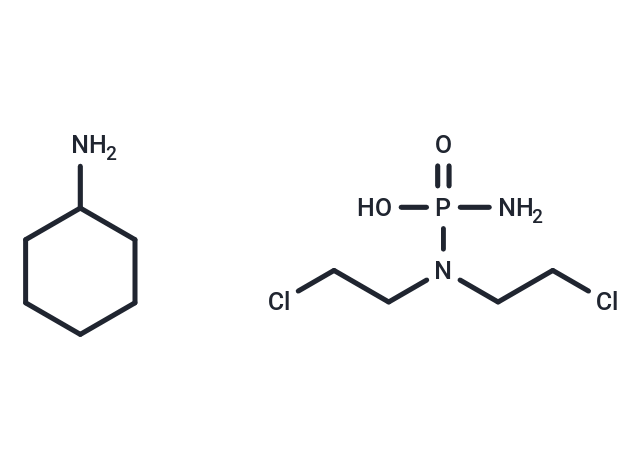Shopping Cart
- Remove All
 Your shopping cart is currently empty
Your shopping cart is currently empty

Phosphoramide mustard cyclohexanamine is the major metabolite for Cyclophosphamide , with anticancer activitiy. Phosphoramide mustard cyclohexanamine induces DNA adduct formation in ovarian granulosa cells, induces DNA damage and elicits the ovarian DNA repair response[1][2].


| Description | Phosphoramide mustard cyclohexanamine is the major metabolite for Cyclophosphamide , with anticancer activitiy. Phosphoramide mustard cyclohexanamine induces DNA adduct formation in ovarian granulosa cells, induces DNA damage and elicits the ovarian DNA repair response[1][2]. Phosphoramide mustard cyclohexanamine causes cytotoxicity through forming cross-linked DNA adducts which inhibit DNA strand separation during replication[1].Phosphoramide mustard cyclohexanamine destroys rapidly dividing cells by forming NOR-G-OH, NOR-G and G-NOR-G adducts with DNA, potentially leading to DNA damage[1].Phosphoramide mustard cyclohexanamine (3-6 μM; 48 hours) reduces cell viability in rat spontaneously immortalized granulosa cells (SIGCs)[1].Phosphoramide mustard cyclohexanamine (3-6 μM; 24-48 hours) induces DNA adduct formation[1].Phosphoramide mustard cyclohexanamine (3-6 μM; 24-48 hours) induces ovarian DNA damage in rat ovaries[1].Phosphoramide mustard cyclohexanamine increases DNA damage responses (DDR) gene (Atm, Parp1, Prkdc, Xrcc6, Brca1, Rad51) mRNA expression level[1].Phosphoramide mustard cyclohexanamine (3-6 μM; 24-48 hours) increased DDR proteins[1]. Cell Viability Assay[1] Cell Line: SIGCs Phosphoramide mustard cyclohexanamine (2.1-20.7 mg/kg; i.p.; daily; for 5 days) inhibits subcutaneous tumor growth in rats[2].Phosphoramide mustard cyclohexanamine (86.0 mg/kg; i.v.) has a plasma disappearance half-life of 15.1 minutes[2]. Animal Model: Rat, subcutaneously implanted Walker 256 carcinosarcoma tumor[2] [1]. Shanthi Ganesan, et al. Phosphoramide mustard exposure induces DNA adduct formation and the DNA damage repair response in rat ovarian granulosa cells. Toxicol Appl Pharmacol. 2015 Feb 1; 282(3): 252-258. [2]. S Genka, et al. Brain and plasma pharmacokinetics and anticancer activities of cyclophosphamide and phosphoramide mustard in the rat. Cancer Chemother Pharmacol. 1990;27(1):1-7. |
| In vitro | Phosphoramide mustard cyclohexanamine induces cytotoxicity through the formation of cross-linked DNA adducts, inhibiting DNA strand separation during replication and forming NOR-G-OH, NOR-G, and G-NOR-G adducts leading to DNA damage. At concentrations of 3-6 μM for 24-48 hours, it reduces cell viability in rat spontaneously immortalized granulosa cells (SIGCs), induces DNA adduct formation and ovarian DNA damage, and increases DNA damage response (DDR) gene (Atm, Parp1, Prkdc, Xrcc6, Brca1, Rad51) mRNA expression levels and DDR proteins. |
| In vivo | Phosphoramide mustard cyclohexanamine (2.1-20.7 mg/kg; i.p.; daily; for 5 days) inhibits subcutaneous tumor growth in rats implanted with Walker 256 carcinosarcoma tumor. Additionally, phosphoramide mustard cyclohexanamine (86.0 mg/kg; i.v.) demonstrates a plasma disappearance half-life of 15.1 minutes[2]. |
| Molecular Weight | 320.19 |
| Formula | C10H24Cl2N3O2P |
| Cas No. | 1566-15-0 |
| Storage | Powder: -20°C for 3 years | In solvent: -80°C for 1 year | Shipping with blue ice. |

Copyright © 2015-2025 TargetMol Chemicals Inc. All Rights Reserved.